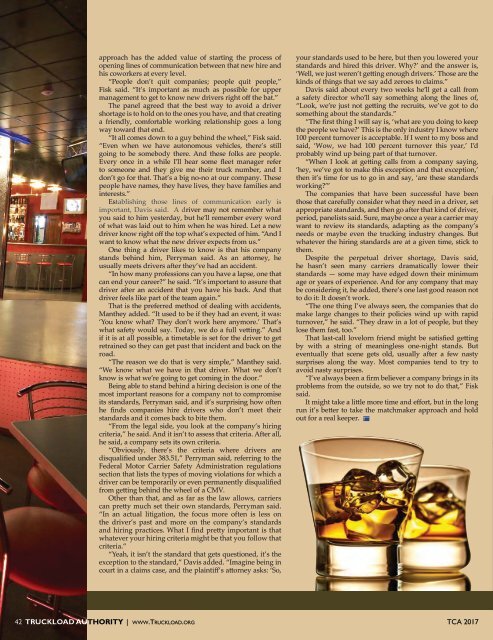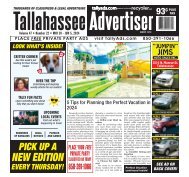TLA25_AllPages_R
You also want an ePaper? Increase the reach of your titles
YUMPU automatically turns print PDFs into web optimized ePapers that Google loves.
approach has the added value of starting the process of<br />
opening lines of communication between that new hire and<br />
his coworkers at every level.<br />
“People don’t quit companies; people quit people,”<br />
Fisk said. “It’s important as much as possible for upper<br />
management to get to know new drivers right off the bat.”<br />
The panel agreed that the best way to avoid a driver<br />
shortage is to hold on to the ones you have, and that creating<br />
a friendly, comfortable working relationship goes a long<br />
way toward that end.<br />
“It all comes down to a guy behind the wheel,” Fisk said.<br />
“Even when we have autonomous vehicles, there’s still<br />
going to be somebody there. And these folks are people.<br />
Every once in a while I’ll hear some fleet manager refer<br />
to someone and they give me their truck number, and I<br />
don’t go for that. That’s a big no-no at our company. These<br />
people have names, they have lives, they have families and<br />
interests.”<br />
Establishing those lines of communication early is<br />
important, Davis said. A driver may not remember what<br />
you said to him yesterday, but he’ll remember every word<br />
of what was laid out to him when he was hired. Let a new<br />
driver know right off the top what’s expected of him. “And I<br />
want to know what the new driver expects from us.”<br />
One thing a driver likes to know is that his company<br />
stands behind him, Perryman said. As an attorney, he<br />
usually meets drivers after they’ve had an accident.<br />
“In how many professions can you have a lapse, one that<br />
can end your career?” he said. “It’s important to assure that<br />
driver after an accident that you have his back. And that<br />
driver feels like part of the team again.”<br />
That is the preferred method of dealing with accidents,<br />
Manthey added. “It used to be if they had an event, it was:<br />
‘You know what? They don’t work here anymore.’ That’s<br />
what safety would say. Today, we do a full vetting.” And<br />
if it is at all possible, a timetable is set for the driver to get<br />
retrained so they can get past that incident and back on the<br />
road.<br />
“The reason we do that is very simple,” Manthey said.<br />
“We know what we have in that driver. What we don’t<br />
know is what we’re going to get coming in the door.”<br />
Being able to stand behind a hiring decision is one of the<br />
most important reasons for a company not to compromise<br />
its standards, Perryman said, and it’s surprising how often<br />
he finds companies hire drivers who don’t meet their<br />
standards and it comes back to bite them.<br />
“From the legal side, you look at the company’s hiring<br />
criteria,” he said. And it isn’t to assess that criteria. After all,<br />
he said, a company sets its own criteria.<br />
“Obviously, there’s the criteria where drivers are<br />
disqualified under 383.51,” Perryman said, referring to the<br />
Federal Motor Carrier Safety Administration regulations<br />
section that lists the types of moving violations for which a<br />
driver can be temporarily or even permanently disqualified<br />
from getting behind the wheel of a CMV.<br />
Other than that, and as far as the law allows, carriers<br />
can pretty much set their own standards, Perryman said.<br />
“In an actual litigation, the focus more often is less on<br />
the driver’s past and more on the company’s standards<br />
and hiring practices. What I find pretty important is that<br />
whatever your hiring criteria might be that you follow that<br />
criteria.”<br />
“Yeah, it isn’t the standard that gets questioned, it’s the<br />
exception to the standard,” Davis added. “Imagine being in<br />
court in a claims case, and the plaintiff’s attorney asks: ‘So,<br />
your standards used to be here, but then you lowered your<br />
standards and hired this driver. Why?’ and the answer is,<br />
‘Well, we just weren’t getting enough drivers.’ Those are the<br />
kinds of things that we say add zeroes to claims.”<br />
Davis said about every two weeks he’ll get a call from<br />
a safety director who’ll say something along the lines of,<br />
“Look, we’re just not getting the recruits, we’ve got to do<br />
something about the standards.”<br />
“The first thing I will say is, ‘what are you doing to keep<br />
the people we have?’ This is the only industry I know where<br />
100 percent turnover is acceptable. If I went to my boss and<br />
said, ‘Wow, we had 100 percent turnover this year,’ I’d<br />
probably wind up being part of that turnover.<br />
“When I look at getting calls from a company saying,<br />
‘hey, we’ve got to make this exception and that exception,’<br />
then it’s time for us to go in and say, ‘are these standards<br />
working?’”<br />
The companies that have been successful have been<br />
those that carefully consider what they need in a driver, set<br />
appropriate standards, and then go after that kind of driver,<br />
period, panelists said. Sure, maybe once a year a carrier may<br />
want to review its standards, adapting as the company’s<br />
needs or maybe even the trucking industry changes. But<br />
whatever the hiring standards are at a given time, stick to<br />
them.<br />
Despite the perpetual driver shortage, Davis said,<br />
he hasn’t seen many carriers dramatically lower their<br />
standards — some may have edged down their minimum<br />
age or years of experience. And for any company that may<br />
be considering it, he added, there’s one last good reason not<br />
to do it: It doesn’t work.<br />
“The one thing I’ve always seen, the companies that do<br />
make large changes to their policies wind up with rapid<br />
turnover,” he said. “They draw in a lot of people, but they<br />
lose them fast, too.”<br />
That last-call lovelorn friend might be satisfied getting<br />
by with a string of meaningless one-night stands. But<br />
eventually that scene gets old, usually after a few nasty<br />
surprises along the way. Most companies tend to try to<br />
avoid nasty surprises.<br />
“I’ve always been a firm believer a company brings in its<br />
problems from the outside, so we try not to do that,” Fisk<br />
said.<br />
It might take a little more time and effort, but in the long<br />
run it’s better to take the matchmaker approach and hold<br />
out for a real keeper.<br />
42 Truckload Authority | www.Truckload.org TCA 2017

















